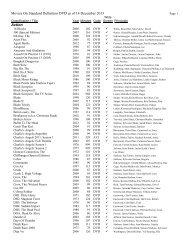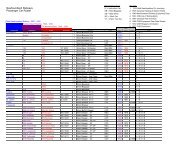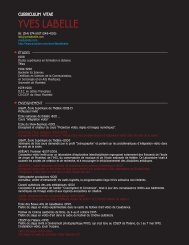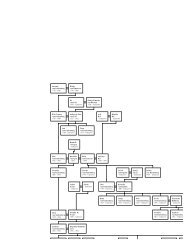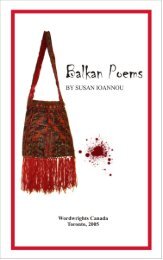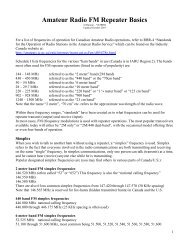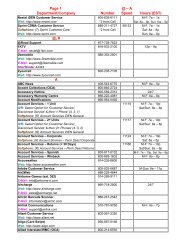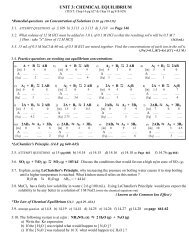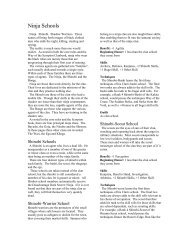Audacious and Adamant - Sympatico
Audacious and Adamant - Sympatico
Audacious and Adamant - Sympatico
- No tags were found...
Create successful ePaper yourself
Turn your PDF publications into a flip-book with our unique Google optimized e-Paper software.
to the maverick spirit of alberta
Copyright © 2007 The Glenbow MuseumAll rights reserved. No part of this work covered by the copyrights hereon may be reproducedor used in any form or by any means—graphic, electronic or mechanical, includingphotocopying, recording, taping or information storage <strong>and</strong> retrieval systems—without theprior written permission of the publisher, or, in case of photocopying or other reprographiccopying, a licence from Access Copyright, the Canadian Copyright Licensing Agency, OneYonge Street, Suite 1900, Toronto, Ontario, M6B 3A9.____________________________________________________________________________Library <strong>and</strong> Archives Canada Cataloguing in PublicationVan Herk, Aritha, 1954–<strong>Audacious</strong> <strong>and</strong> adamant: the story of maverick Alberta / Aritha van Herk.ISBN 1-55263-854-51. Alberta—History. I. Title.FC3661.V359 2006 971.23 C2006-902905-9____________________________________________________________________________The publisher gratefully acknowledges the support of the Canada Council for the Arts <strong>and</strong>the Ontario Arts Council for its publishing program. We acknowledge the support of theGovernment of Ontario through the Ontario Media Development Corporation’s OntarioBook Initiative.We acknowledge the financial support of the Government of Canada through the BookPublishing Industry Development Program (BPIDP) for our publishing activities.Key Porter Books LimitedSix Adelaide Street East, Tenth FloorToronto, OntarioCanada M5C 1H6www.keyporter.comDesign: Marijke FriesenPrinted <strong>and</strong> bound in China06 07 08 09 10 5 4 3 2 1
Table of C ontentsacknowledgements 7foreword by Michael Robinson, C.M. 8audacious <strong>and</strong> adamant 11exploration <strong>and</strong> fur 13David Thompson, Koo Koo Sint or “Star Gazer,” (1770–1857)uninvited guests 17Captain John Palliser, (1817–1887); D.W. Davis, (1849–1906); MotherMary Greene, (1843–1894)mounties <strong>and</strong> mustangs 25James Farquharson Macleod, (1836–1894); Mary Macleod, (1852–1933)Jerry Potts, (ca. 1840–1896); Frederick Augustus Bagley, (1858–1945)building the railway 33Sir William Cornelius Van Horne, (1843–1915)settlement <strong>and</strong> scenery 37Mary Schäffer Warren, (1861–1939); William Pearce, (1848–1930)ranching <strong>and</strong> riding 47Sam Livingston, (1831–1897); John Ware, (1850–1905); George Lane,(1856–1925); Tom Three Persons, (1888–1949)fighting injustice 51Frederick Haultain, (1856–1942); Bob Edwards, (1860–1922); HenriettaMuir Edwards, (1849–1931)
grassroots politics 59Henry Wise Wood, (1860–1941); William Aberhart, (1878–1943); PrestonManning, (b. 1942)newcomers 67James Mah Poy, (1878–1959); Emilio Picariello, (1879–1923); FilumenaLos<strong>and</strong>ro, (1900–1923); Thomas Gushul, (1889–1962); Lena Gushul,(1898–1982); Barons Josef <strong>and</strong> Endre Csavossy, Josef (1894–1979),Endre (1897–1981)war <strong>and</strong> the homefront 77Samuel Benfield Steele, (1849–1919); Frederick McCall, (1895–1949);Mary Julia Dover, (1905–1994); Ryutaro Nakagama, (1906–1990)oil <strong>and</strong> gas 85William Stewart Herron, (1870–1939); Bill Herron, (1908–1989);Charles Stalnaker, (1891–1979); Helen Belyea, (1913–1986); Ted Link,(1897–1980); Jack Gallagher, (1916–1998); Peter Lougheed, (b. 1928)post haste 93Eric Lafferty Harvie, (1892–1975); J.B. Cross, (1903–1990); MarionNicoll, (1909–1985); Melvin Crump, (ca. 1911); Regina Cheremeteff,(1912–1992); Stuart Hart, (1915–2003); Bill Pratt, (1928–1999)afterword 101image credits 103[6]<strong>Audacious</strong> <strong>and</strong> <strong>Adamant</strong>
AcknowledgementsResearch for this book was contributed by Paul Chastko, Gerry Conaty,Frank Dabbs, Adriana Davies, Hugh Dempsey, John Gilpin, LawrieKnight Steinbach, Lorain Lounsberry, Graham MacDonald, RodMartin, Catharine Mastin, Shirlee Smith Matheson, S<strong>and</strong>ra MortonWeizman, Douglas Nelson, Joy Oetelaar, Anthony Rasporich, BradRennie, Frances Roback, Sheila Ross, Janice Sanford Beck, CherylSanford, Lee Shedden, Josephine Smart, Gayle Thrift, Ken Tingley, RonUlrich, <strong>and</strong> Rochelle Yamagishi. Without their invaluable work, neitherthis book nor the Mavericks exhibition would exist.Many people at the Glenbow Museum <strong>and</strong> at Key Porter Booksensured the success of this project. Special thanks to Doug Cass, JocelyneDaw, Melanie Kjorlien, Michale Lang, Lorain Lounsberry, Lisa Making,Owen Melenka, Michael Moul<strong>and</strong>, Anna Porter, Tanis Shortt, <strong>and</strong> HollySchmidt.Finally, thanks to my maverick friends <strong>and</strong> family, whose enthusiasmfor Alberta matches my own.Acknowledgements [7]
<strong>Audacious</strong> <strong>and</strong> <strong>Adamant</strong>Alberta’s character is as unpredictable as her politics, prosperity, or prevailingwinds. Shaped by stunning geography, an encircling sky, <strong>and</strong>the sweet chinook, Alberta is as much eccentric as ordinary, as muchdeceptive as downright honest. Seductive <strong>and</strong> irascible, this place is tenderas the green of sage <strong>and</strong> exciting as an ear-splitting thunderstorm. AndAlberta is home to mavericks, inspired <strong>and</strong> determined risk-takers, creative,eager to embrace change.Why mavericks? Texas rancher Samuel A. Maverick did not wish tobr<strong>and</strong> his cattle, so unbr<strong>and</strong>ed calves came to be called mavericks. Politicianswho refused to acknowledge party allegiance were called mavericks.Mavericks refused to be owned or corralled or controlled.Maverick Albertans propelled this province in new directions. Notone sat back with folded h<strong>and</strong>s. They seized challenges <strong>and</strong> blessings,embraced fear <strong>and</strong> hope. Laconic, but never speechless, opinionated butnever immovable, Alberta’s collective imagination followed a distinctivetrail. Geological upheavals going back hundreds of millions of yearsbequeathed to the present both gorgeous scenery <strong>and</strong> valuable resources.It is as if the forces that lifted the plates of the Rockies have carved theirsignatures on Alberta’s soul.Albertans ride a maelstrom of change as forceful as a tornado, contemporaryas digital communication. We embrace the present <strong>and</strong> celebratethe past, a past resonant with audacious, adamant, <strong>and</strong> adventurouscharacters. These mavericks inscribed on Alberta’s past a prediction forAlberta’s future. They speak to the formation of a character sometimesacerbic <strong>and</strong> adversarial, but ultimately affirmative, inclusive, <strong>and</strong> intriguing.Opposite page: The Narrows,Maligne Lake, Alberta<strong>Audacious</strong> <strong>and</strong> <strong>Adamant</strong> [11]
Ranching <strong>and</strong> RidingSam Livingston’s farm now sleeps covered by the waters of the GlenmoreDam. One of the oldest homesteads in southern Alberta, that l<strong>and</strong>witnessed many of the conflicts that followed the vanishing of thebuffalo <strong>and</strong> the opening of their great grassl<strong>and</strong>s to ranching <strong>and</strong> farming.A restless, roving man, Livingston fled the empty belly of the Irishpotato famine, toiled as a farmer in Wisconsin, <strong>and</strong> followed gold fever toCalifornia before heading to Fort Edmonton to work in the robe trade. Heknew hunger <strong>and</strong> privation, for a time subsisting on coyotes <strong>and</strong> hawks.According to him, “hawk soup was a damned bitter brew.” In his travels,he noticed that buffalo were still plentiful around the Bow River <strong>and</strong> in1873, he moved south to the Calgary area.He didn’t look like a farmer. Dressed in buckskins, a wide-brimmed hat,<strong>and</strong> a red b<strong>and</strong>anna, he resembled a frontiersman, hair worn long to hisshoulders, <strong>and</strong> his manner “typically Irish,” full of “language, wit, <strong>and</strong> nervousimpetuosity.” His 1865 marriage to Jane Howse connected him with animportant western family linked to the fur trade; he learned from her kinfolkhow to hunt buffalo. Jane Howse worked beside Livingston. They welcomedfriends <strong>and</strong> travellers to their Big House built of squared logs, witness tocommunity action <strong>and</strong> discussion related to settlement <strong>and</strong> l<strong>and</strong> rights.Arguably the first Calgarian, Livingston considered the Bow Riverarea the perfect home. Observantly, <strong>and</strong> long before the Mounties wereformed, he warned the government about the destructive effects of thewhiskey trade. But although Livingston grazed 300 head of cattle <strong>and</strong>grew a good crop of oats, he was considered squatter more than settler.When the Mounties did show up, they claimed the right to use all thewood <strong>and</strong> grass around Calgary—<strong>and</strong> on Livingston’s l<strong>and</strong>. Although heSam LivingstonOpposite page: Southern Albertaranching countryRanching <strong>and</strong> Riding [41]
Sam Livingstone’s embroideredjackethad a store, they wouldn’t trade with him but boughttheir goods from I.G. Baker. And when the huge l<strong>and</strong>leases were granted, Livingston felt that the policedefended the big ranchers against the farmers. Thisbecame “the battle between cattle <strong>and</strong> men for thecountry,” a war between settlers <strong>and</strong> often absenteeleaseholders, between the open range <strong>and</strong> the plow.Livingston hated regulations <strong>and</strong> all his life didwhat he could to avoid them. He swore that “betweengovernment reserves, leases, school l<strong>and</strong>s, Hudson Bayl<strong>and</strong>s,” a man couldn’t find a place to settle. He felt thatthe country had to be opened up or settlers would burntheir buildings <strong>and</strong> leave. “For the present,” hedeclared, “I defend my claim as my neighbours do,behind my Winchester.” In a time of tenuous justice,he headed the Settlers’ Rights Association, <strong>and</strong> led thefight to persuade the federal government that l<strong>and</strong>leases where no stock was being grazed should beopened up to farmers.Jane Howse too inventively fought discrimination. Once, when Samwas away <strong>and</strong> she had to go into Calgary for medicine for a sick baby, shepowdered her face with flour to whiten her skin. She was afraid that shewould be stopped <strong>and</strong> prevented from entering the city; the laws of thetime decreed that First Nations people were not supposed to leave thereserve without a pass. Such unfairness was exactly what she <strong>and</strong>Livingston resisted. Together, they had fourteen children, born over thirtyyears, the youngest only a year old when Livingston died in 1897. Bothbelieved firmly in education, <strong>and</strong> Sam was elected one of the first trusteesfor the Glenmore School in 1888. Artistically gifted, Jane embroidered forLivingston a spectacular tanned elk hide jacket, the flowers those of theCanadian prairie.Jane LivingstonLivingston’s fee for a homestead pre-emption on l<strong>and</strong> he had workedfor a decade was finally accepted in 1885. By that time, the grazinglease program was in effect. Logically enough, with the buffalo gone,the grassl<strong>and</strong>s began to attract the attention of ranchers. If 50 million[42]<strong>Audacious</strong> <strong>and</strong> <strong>Adamant</strong>
John Ware’s Ranch at Duchess,Alberta, by Rol<strong>and</strong> GissingNot content to work for others, Ware wanted his own outfit. In 1887,his wages totalled $55 in cash <strong>and</strong> $110 in sundries. That was not a princelysum, but it was enough to buy a few cattle <strong>and</strong> for John Ware to begin hisown herd, although he still worked as a cowboy. Slowly, he bought morestock, then established a ranch close to Sheep Creek. He built a house, <strong>and</strong>in 1892 married Mildred Lewis.They were an unlikely couple. She feared cattle <strong>and</strong> never rode a horsein her life, although she eventually learned to milk a cow. Educated <strong>and</strong> wellgroomed, Mildred might not have imagined marrying a rancher. She wasonly twelve when her family moved from Toronto, seeking better opportunitiesin the West. Daniel Lewis, Mildred’s father, helped to build many ofthe early houses in Calgary. A finishing carpenter, his craft was displayedin cabinets, bookcases, <strong>and</strong> staircases. They attended the Baptist church,where Mildred probably met John Ware. Stories say that it took the bigcowboy years to learn about the Lewis family, but once he did, he wasquick to get himself invited to dinner. The Calgary Tribune’s congratulationson their wedding were reassuring: “The bride is of a happy disposition,well cultured <strong>and</strong> accomplished, <strong>and</strong> probably no man in the district has[44]<strong>Audacious</strong> <strong>and</strong> <strong>Adamant</strong>
a greater number of warm personal friends than the groom, Mr. JohnWare.” The two shared a deep connection. She read the newspaper to him,<strong>and</strong> she was in charge of bookkeeping for the ranch.When farming began to encroach on the open range, Ware sold thefoothills property <strong>and</strong> bought on the Red Deer River northeast of Brooks.One of the earliest Black pioneers in Alberta, Ware refused to recognizethe colour bar. He did what he did, did it well, <strong>and</strong> enjoyed the respect ofthe entire community, although he could neither read nor write. Andwhile he vanquished outlaw horses, he was gentle with people <strong>and</strong> lovedvisiting <strong>and</strong> dancing. He <strong>and</strong> Mildred had six children together, <strong>and</strong> herearly death, of typhoid <strong>and</strong> pneumonia, devastated him. His daughterNettie said, “Dad was not the same man after we lost Mother.” As if tounderline that truth, Ware was killed only a few months later when hishorse stepped in a gopher hole <strong>and</strong> fell on top of him.The entire community mourned him, none more than ranchingfriend George Lane, one of his pallbearers. Like Ware, Lane was anAmerican who had come north. His on-the-job training in Montana consistedof riding <strong>and</strong> roping, but he did not stop at the hooves <strong>and</strong> hides ofGeorge Lane (right) with the Princeof WalesRanching <strong>and</strong> Riding [45]
cattle. His reputation as a capable cowboy meant that he was hired tocome to the North West Territories as the foreman of the Bar U ranch, justoutside of High River. Loose-jointed <strong>and</strong> intense, the tall American quicklybecame boss of the roundup. A fellow rancher described him as “a doublebarrelledback action, high pressure, electrical dynamo at top speed.”Sensibly adapting effective farming <strong>and</strong> ranching practices to suit localconditions, Lane bought <strong>and</strong> sold beef, exported <strong>and</strong> imported horses, <strong>and</strong>slowly improved his position until, in 1902, he outmanoeuvred big moneyinterests to buy the beautiful Bar U, the ranch where he had first worked.The plain-spoken stockman who hit the country with $100 in his pocket<strong>and</strong> who worked for $100 a month had aced the largest ranch sale inAlberta’s history. Everyone was astonished but George Lane was smart<strong>and</strong> shrewd rather than lucky; his business acumen grew from payingclose attention, even though his education was the school of horse knocks.Under his watch the Bar U came to represent far more than a successfulranch. His cattle broke records at the Chicago stock markets. Heworked to benefit ranchers <strong>and</strong> farmers alike, battling the cpr’s freightrates <strong>and</strong> export tariffs. He combined ranching with mixed farming tocushion unexpected reversals in weather or pricing. He argued the importanceof preserving the eastern slopes for grazing. Knowing that incomingsettlers would need workhorses, he bred Percherons for sale. He becamesomething of a horse ambassador to the world, even though, progressively,he bought his first automobile in 1910. It is little wonder that royalty,politicians, <strong>and</strong> personalities were attracted to the beautiful Bar U <strong>and</strong> itstaciturn owner. Even the Prince of Wales came to visit, later declaring thatalthough he had been on the ranch for only twenty-four hours, he wishedit had been twenty-four years. Lane helped the Prince to buy the ranchnext door, renamed the E.P. after Edward Prince of Wales.Lane’s old pepper-<strong>and</strong>-salt cutaway frock coat <strong>and</strong> battered hat madehim seem ordinary. But his pride was unshakeable. He said, “always keepyourself in a position to look any man straight in the eye <strong>and</strong> tell him togo to hell.” Although he began without wealth or political connections,Lane became a spokesman for agriculture, Alberta’s beef, horses, <strong>and</strong>grain. And knowing that the heritage of ranching was as fleeting as summerrain, he was one of the Big Four ranchers who agreed in 1912 to backGuy Weadick’s idea of a spectacular Stampede. The legacy of the CalgaryStampede, a celebration of the past <strong>and</strong> a harbinger of the future, is justone measure of George Lane’s foresight.[46]<strong>Audacious</strong> <strong>and</strong> <strong>Adamant</strong>
The Big Four:Pat Burns, GeorgeLane, A.E. Cross,<strong>and</strong> Archie McLean.They fronted the firstCalgary Stampede,1912Ranching <strong>and</strong> Riding [47]
With the era of the big ranches passing, the ranch h<strong>and</strong>s that seemedable to do anything from the back of a horse quickly became the stuff oflegend. The men of the open range worked hard, but they also representeda vanishing way of life. More <strong>and</strong> more settlers <strong>and</strong> sodbusters, drawn bythe promise of free l<strong>and</strong>, were beginning to filter west, bringing the leaseholdera to an end. The Golden Age of ranching lasted less than thirtyyears, but it br<strong>and</strong>ed southern Alberta forever.Tom Three PersonsThe unquenchable spirit of that time is celebrated in small countryrodeos as well as “The Greatest Outdoor Show on Earth.” Calgary’scowboy roots go deep, <strong>and</strong> in 1912 American Guy Weadick’s idea of anevent that would celebrate the past was met with enthusiasm by the BigFour ranchers—Pat Burns, George Lane, A.E. Cross, <strong>and</strong> Archie McLean—who together agreed to front up to $100,000 against losses. Weadickbelieved that a western competition, including bull dogging, trick riding,<strong>and</strong> roping, would put Calgary onthe map.No one could resist the allureof watching broncobusting <strong>and</strong>steer wrestling, <strong>and</strong> the best cowboysin the West were eager tocompete for the generous $20,000purse at the first Stampede. Mostimportant, Weadick was determinedthat the First Nations peoplewould be a part of the spectacle.According to federal regulations,Indians were not allowed to attendrodeos, <strong>and</strong> could not even leavetheir reserves without a pass.Despite predictable resistance, Weadick ensured that 2,000 Native peopleswould attend the Stampede <strong>and</strong> would lead the gala parade. Lead theydid, in their most colourful regalia <strong>and</strong> on their best horses, while 80,000people watched <strong>and</strong> applauded.The highlight of that first Stampede occurred when a youngKainai man rode Cyclone, the unbeatable bronc, to a st<strong>and</strong>still. From the[48]<strong>Audacious</strong> <strong>and</strong> <strong>Adamant</strong>
governor general to the smallestwide-eyed kid, everyone watched.Cyclone had never been ridden.He had thrown 129 cowboysbefore the day of the competitionwhen Tom Three Persons stood,feet in the stirrups, <strong>and</strong> waitedfor the outlaw horse to leap to itsfeet. The two, locked in a battleof wits <strong>and</strong> muscle, put on aspectacular show. The horsetwisted <strong>and</strong> corkscrewed, jackknifed<strong>and</strong> hopped, but the manstayed aboard, until at last thehorse gave in.Both the horse <strong>and</strong> his vanquisher were fighters. Torn betweenCatholicism <strong>and</strong> his own Native spirituality, pushed <strong>and</strong> pulled by White laws<strong>and</strong> traditional customs, Three Persons balanced on the edge between old<strong>and</strong> new ways. Son of a White trader <strong>and</strong> a Kainai woman, Double Talker,he was raised by Double Talker’s second husb<strong>and</strong>, taught by an uncle,Bobtail Chief, <strong>and</strong> briefly educated at St. Joseph’s Indian Industrial School(known as the Dunbow school), before starting work as a ranch h<strong>and</strong>. Aquick study, his skills with cattle, roping, <strong>and</strong> horses were extraordinary.Tom Three Persons learned the hard way that he needed determinationto succeed in an unforgiving White man’s world. He was a shrewdbusinessman who worked hard to acquire l<strong>and</strong> <strong>and</strong> cattle, <strong>and</strong> by the timehe died, he was one of the leading stockmen on his reserve, the first in hiscommunity to grow grain crops.When Tom Three Persons rode Cyclone to a st<strong>and</strong>still, he presagedAboriginal pride, but he also signalled the future of the Calgary Stampede.It was such a success that plans were made to hold another in 1915, but theFirst World War intervened, <strong>and</strong> the Calgary Stampede did not become ayearly event until 1923. The demise of the golden age of ranching meant thatrodeos became one place where cowboy skills are still celebrated.Br<strong>and</strong>ing cattle at George Lane’sBar U RanchRanching <strong>and</strong> Riding [49]



